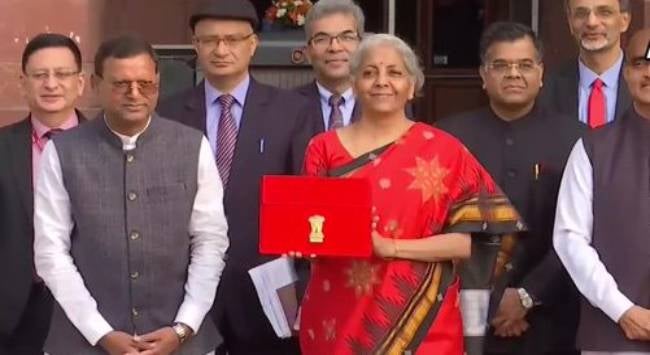India Budget FY2023-24:
Emphasising Growth amidst a Cloudy Global Outlook
Amitendu Palit
7 February 2023Summary
The last full budget of the Narendra Modi government has focused on maintaining a stable growth trajectory by enhancing investment in infrastructure and boosting consumption through lower taxes. Its success will depend on India’s macroeconomic resilience in the face of difficult external conditions.
With barely 15 months to India’s next general election in 2024, the budget presented by Finance Minister Nirmala Sitharaman on 1 February 2023 for FY2023-24 was the Narendra Modi government’s last full budget in its second term. The budget has identified core economic priorities for the Modi government as it prepares for the upcoming Lok Sabha elections. It is also a budget presented against the backdrop of a looming global recession and India’s presidency of the G20.
The Indian economy has gathered strong momentum after shaking off the disruptions caused by COVID-19. The economy grew by seven per cent in FY2022-23. The pre-budget Economic Survey projects a similar baseline gross domestic product (GDP) growth of 6.5 per cent in FY23-24. This is broadly consistent with the International Monetary Fund’s assessment of India growing by 6.8 per cent in FY2022-23, followed by a fall in growth to 6.1 per cent in FY2023-24. It is important for the Indian economy to grow at its projected rate, not just for good prospects of the Modi government in the upcoming election of 2024, but also because India is the only economy in the heavily populous South Asian region that is performing well without any major macroeconomic setbacks.
Fast-depreciating national currencies, mounting debt service, high import bills, depleting foreign exchange reserves and rising inflation has inflicted economic hardships of varying degree on Sri Lanka, Pakistan, Nepal and Bangladesh. As South Asia’s largest economy with strong trade and connectivity linkages with the rest of the region, India’s ability to grow at six per cent plus will support the region as a market for goods and services and as a source of raw materials, intermediates and final products.
India’s ability to grow at the projected rate is also important for the world economy at large. Among the world’s major economies, including the G20, India has the best growth prospect for FY2023-24. Good growth by India will contribute significantly to the overall global GDP growth, which is facing a gloomy outlook on the account of sharp cutbacks in growth projections for the United States and Europe.
The Indian budget, therefore, had to ensure that the economy continues to remain on a robust growth path. Two conditions are necessary for ensuring so. The first is making funds available to maintain investments in key projects. The second is to make sure that private consumption demand does not falter. The budget has worked on the first by sharply raising capital expenditure. More than 30 per cent raised is through higher outlays for infrastructure projects. Simultaneously, new infrastructure projects would generate employment and act as a force multiplier for economic growth by raising both investment and consumption demand.
Important announcements for infrastructure include the continuation of interest-free loans by the central government to the states to incentivise infrastructure growth; identifying several transport projects for end-to-end connectivity; and ensuring a big push on urban infrastructure in Tier 2 and 3 cities, along with the establishment of the Urban Infrastructure Development Fund.
The second condition for maintaining the growth momentum has been attempted through lowering personal and corporate income taxes. Although the political appeal of the move is obvious, such measures could not have been announced unless the government was confident about mobilising sufficient revenues despite lowering taxes. The confidence has arisen from the success in mobilising tax revenues in FY2022-23. According to the revised estimates for FY2022-23, collections of corporate tax, income tax and goods and services tax have been higher than the budgeted estimates. The government clearly feels it will be able to repeat the performance.
There is much the budget can achieve if the underlying conditions remain favourable. Apart from ensuring that the economy remains on a stable growth track of six per cent plus, it can accelerate the economy’s transition to ‘green’ growth and people-friendly Artificial Intelligence applications. On both the latter, the budget has been supportive through a set of far-reaching policies.
The challenge is to ensure that India’s macroeconomic fundamentals remain strong despite unforeseen developments. Exogenous shocks like fresh bursts of COVID-19 infections, extreme weather events and geo-political conflicts with economic repercussions could pose risks to macroeconomic fundamentals. If severe, they would force the withdrawal from the policy stance of facilitating growth for crisis management. That would constrain the budget from realising its goals.
. . . . .
Dr Amitendu Palit is a Senior Research Fellow and Research Lead (Trade and Economics) at the Institute of South Asian Studies (ISAS), an autonomous research institute in the National University of Singapore (NUS). He can be contacted at isasap@nus.edu.sg. The author bears full responsibility for the facts cited and opinions expressed in this paper.
Pic Credit: Reuters Asia
-
 More From :
More From :
-
 Tags :
Tags :
-
 Download PDF
Download PDF



